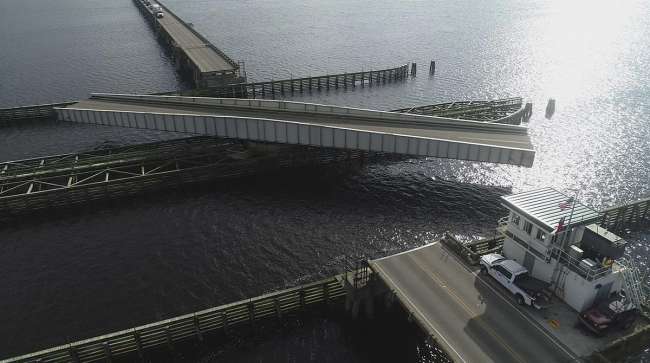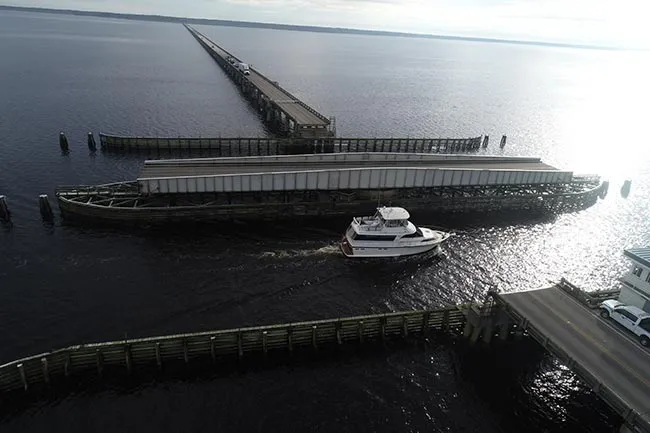Staff Reporter
North Carolina to Replace Key Alligator River Bridge

[Stay on top of transportation news: Get TTNews in your inbox.]
Design work is progressing on a project to convert the aging Alligator River Bridge from a two-lane swing to a fixed span bridge in a critical freight corridor on U.S. Route 64 in North Carolina.
The $226.3 million project, partially funded through a recent $110 million bipartisan infrastructure mega federal grant awarded earlier this year, is vital to travelers on North Carolina’s northeastern coast.
With construction to begin in 2025, the new two-lane bridge will feature a 65-foot vertical clearance over the navigation channel where 4,000 boats pass through annually.
The current bridge (also called the Lindsay C. Warren Bridge) has been rated “structurally deficient” for reaching the end of its useful life after being completed around 1960.

When the bridge won't open, boaters also must detour. (North Carolina Department of Transportation)
When periodic electrical or mechanical issues arise, the bridge can remain stuck in an open position or frozen shut for hours or days. Truckers and other motorists must take a 100-mile detour if the bridge is broken in an open position. When it won’t open, boaters must also detour.
Carly Olexik, spokesperson for the North Carolina Department of Transportation, told Transport Topics the current bridge closes an average of 10 times per day with an eight-minute wait time per closure.
“The new structure will eliminate the swing span. U.S. 64 is part of the National Highway System, which is critical for freight traffic,” Olexik added. “The bridge also crosses the intercoastal waterway and is part of the National Multimodal Freight Network. A fixed-span bridge will increase freight vessel passage.”
Alligator River Bridge, among NCDOT’s Strategic Transportation Corridors, is the only designated local expressway providing a primary east-west route to the northeastern state between Interstate 95, U.S. Route 17 and the Outer Banks.
“The new structure will eliminate the swing span, which is anticipated to save trucks $32 per hour based on factors such as anticipated diesel fuel cost savings due to the nearly 100-mile detour vehicles currently must take when the bridge is not accessible,” Olexik said.
NCDOT named the project involving the Alligator River bridge STERLING (an acronym for Strengthening Transportation Evacuation Resilient Lifeline by Improving the Network’s Grid) in honor of the late Sterling Baker, a former Division 1 Engineer.
The STERLING project also involves installing broadband between I-95 in Rocky Mount and state Highway 12 in Nags Head.
Olexik said, “The project includes fiber-optic cable upgrades, which will support future automated/connected vehicles. This will future proof the reliability of freight movement. The fiber backbone will allow for high wind warning, increasing safety for traffic to the Outer Banks.”
Want more news? Listen to today's daily briefing above or go here for more info
New safety features are other key elements of the new bridge, which will have 8-foot-wide shoulders and railings of 4.5 feet instead of today’s 1-foot shoulders and railing just under 3 feet.
A gathering was held in March near the Alligator River Bridge to celebrate the federal grant award. In attendance were Gov. Roy Cooper, Federal Highway Administrator Shailen Bhatt and J. Eric Boyette, state transportation secretary.
“For decades to come, this bridge will make driving and boating safer, faster and more efficient for people traveling through this area,” Boyette said. “From aiding in hurricane evacuations to improving our economic development prospects, this project is a great investment in our state’s transportation future.”



